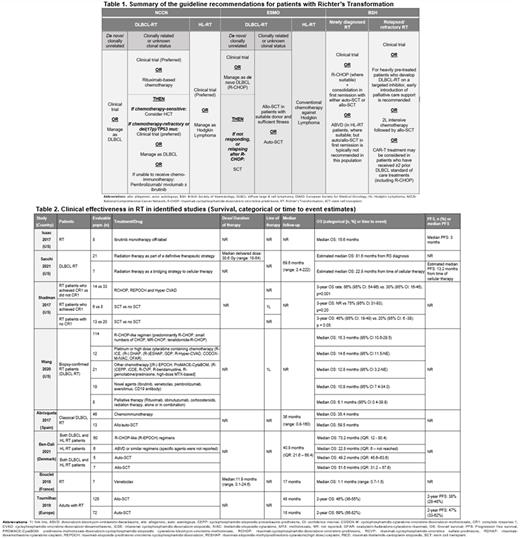Abstract
Background
Richter's transformation (RT) is an uncommon clinicopathological condition that arises as a complication in 5-16% of chronic lymphocytic leukemia (CLL) patients, with an annual incident rate of 0.5-1%. Around 90% of cases present as diffuse large B-cell lymphoma (RT-DLBCL), with Hodgkin Lymphoma variant RT (HL-RT) accounting for 5-10% of transformations. RT is difficult to treat due to its complex molecular and evolutionary patterns.
Aims and objectives
This literature review aimed to summarize the current guideline recommendations, and identify real-world treatment patterns for patients with RT.
Methods
Embase, MEDLINE and MEDLINE in-process databases were searched to identify relevant studies. English language, observational treatment pattern studies and treatment guidelines were included (January 2011-December 2021, inclusive). Recent conference proceedings were manually searched (2019-2021, inclusive). Prespecified PICOS criteria were used for study selection. First screening (titles/abstracts), second screening (full text) and extractions were validated by an independent reviewer.
Results
Of 771 records retrieved, 26 studies (guidelines: n=3; real-world studies: n=23) met the inclusion criteria. Treatment guidelines for patients with RT were identified from NCCN, the British Society of Haematology (BSH) and ESMO (Table 1). Clinical trial enrolment is recommended in patients with DLBCL-RT (NCCN, ESMO, BSH) or HL-RT (NCCN, BSH) at any stage. NCCN and ESMO recommend for clonally unrelated DLBCL-RT to be treated as de novo DLBCL. In clonally related/unknown clonal status DLBCL-RT, NCCN recommend rituximab-based chemoimmunotherapy in 1L, then allogenic Stem Cell Transplant (allo-SCT) in chemo-sensitive patients; and radiation, or pembrolizumab/nivolumab ± ibrutinib in chemo-refractory. ESMO recommend allo-SCT or autogenic-SCT (auto-SCT) for patients with clonally related DLBCL-RT. BSH recommend R-CHOP in treatment naïve DLBCL-RT; and in relapsed refractory (r/r) patients, chemotherapy followed by allo-SCT, CAR-T (in patients after ≥2 prior treatments) or palliative treatment (in heavily pre-treated patients, developing DLBCL-RT on targeted therapy). In HL-RT, NCCN and BSH recommend treatment as per current HL guidelines (i.e., ABVD in 1L). ESMO also recommend conventional chemotherapy in patients with HL-RT. In r/r HL-RT NCCN recommend radiotherapy, auto-SCT, PD-1 inhibitors or chemotherapy.
Nine real-world studies provided data on 1L treatment for patients with RT. The most common 1L treatment in DLBCL-RT was chemoimmunotherapy (66-87%) and in HL-RT it was ABVD (59-67%). Other 1L treatments were chemotherapy combinations, targeted therapies (ibrutinib, venetoclax, everolimus), immunotherapies (pembrolizumab) and SCT. The most common systemic treatments in the US were R-CHOP (50-70%) and REPOCH (3.4-28.6%); compared to R-CHOP (19-73%), ABVD (59.1-70%), allo-SCT (3.6-53.9%) and auto-SCT (8.9-58%) in Europe. Treatment pattern data in r/r patients were limited. One US study reported 42% of r/r DLBCL-RT patients received radiotherapy post chemoimmunotherapy. In r/r HL-RT patients who failed to achieve CR with ABVD (n=3) in Italy, subsequent treatments were chemotherapy+allo-SCT, chemoimmunotherapy+auto-SCT or bendamustine-rituximab (33.3% each). Among RT patients treated with BTK inhibitors in the US (n=9), all patients subsequently received chemoimmunotherapy. Studies reporting survival data (Table 2) and response data were largely heterogeneous in terms of study design; outcomes should be interpreted with caution due to small patient numbers.
Conclusion
Rituximab-based treatments were found to be a mainstay of treatment according to the guidelines. Validating whether real-world treatment patterns were aligned to guidelines was challenging due to limitations in the studies identified (different outcomes, small sample sizes and heterogeneous populations). Patients with r/r RT were underrepresented in the treatment pattern studies. This review highlights the need for novel treatments to improve survival and response outcomes in patients with RT, particularly in patients with r/r disease where current options are limited. All treatment guidelines recommended patient enrolment into clinical trials and increasing enrolment will serve to improve treatment options in this difficult to treat patient population.
Disclosures
Prescott:Merck Sharp & Dohme LLC, a subsidiary of Merck & Co., Inc., Rahway, NJ, USA: Current Employment, Current holder of stock options in a privately-held company. Pandey:Parexel: Current Employment. Hall:Parexel: Current Employment. Nathani:Parexel: Current Employment. Pandey:Parexel: Current Employment. Ryland:Merck & Co., Inc.: Current Employment. Raut:Merck & Co., Inc.: Current Employment. Squires:Merck & Co., Inc.: Current Employment.
Author notes
Asterisk with author names denotes non-ASH members.


